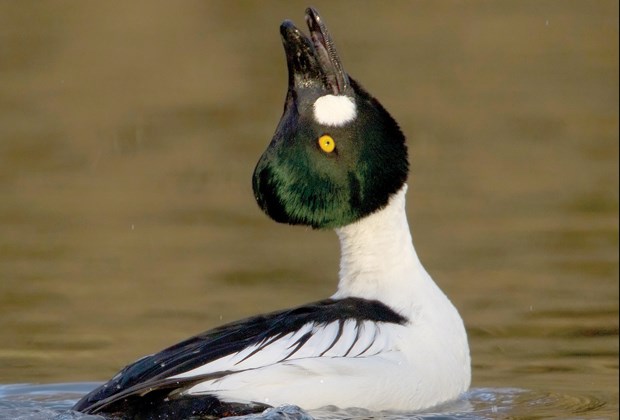It's mid-winter and courtship is in the air.
For many birds, the breeding cycle begins early in the year and a few, like Anna's hummingbirds, nest in winter.
Visitors to the Conservation Area at Maplewood Flats have noticed Anna's doing their amazing courtship displays, and singing. Anna's hummingbird is a local resident, with the Rufous hummingbird arriving in April, about the same time salmonberry and red-flowering currant are blooming.
A hummingbird nest is a marvel of construction, made of animal fur, plant materials, spider silk and lichens. Lichens are placed on the outside of the nest for camouflage and possibly for waterproofing.
Winter feeding sources for hummers include feeders and winter-blooming shrubs like mahonia.
Ducks are commonly seen courting in late winter, although mallards have been doing it for some time now - they start early! Watch for mallards facing each other and bobbing their heads up and down. Goldeneye drakes snap their heads back while offering a nasal note. Two good spots to watch duck behaviour are the west point of the conservation area and the Ambleside Park pond.
Winter is also a great time to photograph waterfowl since they're in the best plumage. Watch for the wood duck, Barrow's goldeneye, bufflehead, hooded merganser and harlequin, to name a few. Listen too for their calls as not all ducks quack. For example, the wood duck whistles, and the greenwinged teal sounds like a cricket.
Black-capped chickadees have recently been seen exploring nesting holes. They too start early, selecting a suitable nesting site. That's why if you're going to put up a nesting box for chickadees do it soon. Sometimes nesting boxes are used for wintering roosting sites serving as a warm place to cuddle. Make sure your box is made to correct specifications, including no perch, can be cleaned easily, has good drainage, etc. A perch is not necessary and will only encourage predators. See your local wild bird shop for best advice.
Woodpeckers, like flickers, are also in a romantic mood. In order to attract a mate and establish a territory, the male drums. Drumming posts include mailboxes, street lamp covers and roof tops. Also listen for the flickers' "kleeer" call, which is another sign of spring. Other woodpeckers also do tapping. It's fun to try and identify them by these sounds. Feeder watchers have no doubt noticed good numbers of pine siskins on the North Shore this winter. They have also been seen feeding on seeds of red alder trees, a favourite food. Listen for the siskins' "zeeep" call, like drawing your thumbnail across a plastic comb.
Courtship indeed is in the air. Enjoy the birds. Keep safe.
Al Grass is a naturalist with the Wild Bird Trust of British Columbia, which offers free walks at the Conservation Area at Maplewood Flats on the second Saturday of every month. The next walk will be Saturday, Feb. 14, starting at 10 a.m. Participants will look for signs of courtship among resident birds. Meet at WBT's site office, 2645 Dollarton Hwy. Walks go rain or shine. wildbirdtrust.org



